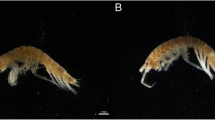Abstract
Amphipods of the genus Melita (Melitidae, Amphipoda) were found in the Kerch Strait (Black Sea) in September 2019 and March, July, and November 2020. The material was collected in the formations formed by the polychaete Ficopomatus enigmaticus (Fauvel, 1923). The depth ranged from 0.1 to 0.2 m. The individuals found in this site do not belong to the species Melita palmata (Montagu, 1804) known in the Black Sea, but they correspond to the morphological characters of the genus Melita. The species discovered is as close as possible to the species Melita setiflagella Yamato, 1988, whose natural range is located in the estuaries of rivers in Japan. The invasive range covers coastal waters of the Atlantic coast of Europe, the Pacific and Atlantic coasts of the United States, and the Atlantic coast of Argentina. Presumably, this invader was accidentally introduced into the Black Sea with ballast waters or by transfer with fouling of ship surfaces. M. cf. setiflagella formed a stable self-reproducing population in the Kerch Strait. Therefore, it is important to monitor the distribution of this amphipod in order to predict the consequences for endemic species and local ecosystems.


















Similar content being viewed by others
REFERENCES
Coblentz, B.E., Exotic organisms: A dilemma for conservation biology, Conserv. Biol., 1990, pp. 261–265.
Copilaş-Ciocianu, D., Berchi, G., and Mumladze, L., First survey of shallow-water amphipoda along the Georgian Black Sea coast reveals new faunistic records and the unexpected Atlantic invader Melita nitida, Mediterr. Mar. Sci., 2020, vol. 21, no. 2, pp. 460–463. https://doi.org/10.12681/mms.22844
Faasse, M. and van Moorsel, G., The North-American amphipods, Melita nitida Smith, 1873 and Incisocalliope aestuarius (Watling and Maurer, 1973) (Crustacea: Amphipoda: Gammaridea), introduced to the western Scheldt estuary (the Netherlands), Aquat. Ecol., 2003, vol. 37, pp. 13–22. https://doi.org/10.1023/A:1022120729031
Fashchuk, D.Ya. and Petrenko, O.A., The Kerch Strait: A highly important transport artery and fishery region of the Azov–Black Sea basin, Yug Rossii: Ekol. Razvitie, 2008, no. 1, pp. 15–22.
Greze, I.I., Higher crustaceans: Amphipods, Bokoplavy, in Fauna Ukrainy (The Fauna of Ukraine), Kiev: Naukova Dumka, 1985, vol. 26, no. 5.
Grintsov, V. and Sezgin, M., Manual for Identification of Amphipoda from the Black Sea, Sevastopol: DigitPrint, 2011.
Jarrett, N.E. and Bousfield, E.L., The amphipod superfamily Hazdioidea on the Pacific Coast of North America: Family Melitidae. Part 1: The Melita group: Systematics and distributional ecology, Amphipacifica, 1996, vol. 2, no. 2, pp. 7–74.
Kim, C.-Bae, Kim, W., and Kim, H.-Soo, Three species of the genus Melita from Korea (Crustacea, Amphipoda, Melitidae), Korean J. Syst. Zool. Special Issue, 1992, no. 3, pp. 113–120.
Knipovich, N.M., Hydrological research in the Black Sea, Tr. Azovo-Chernomorsk. Eksped., Moscow: Tsentr. Nauchno-Issle. Inst. Rybn. Khoz., 1932, vol. 10.
Krapp-Schickel, T. and Sket, B., Melita mirzajanii n. sp. (Crustacea: Amphipoda: Melitidae), a puzzling new member of the Caspian fauna, Zootaxa, 2015, pp. 248–262. https://doi.org/10.11646/zootaxa.3948.2.6
Matsumasa, M. and Kurihara, S., Distribution patterns of benthic small crustaceans and the environmental factors in brackish shallow-water lagoon, Gamo-Lagoon, Benthos Res., 1988, nos. 33–34, pp. 33–41.
Mills, E.L., Noteworthy Amphipoda (Crustacea) in the collection of the Yale Peabody Museum, Postilla, 1964, no. 79.
Mooney, H.A. and Cleland, E.E., The evolutionary impact of invasive species, Proc. Natl. Acad. Sci. U. S. A., 2001, vol. 98, pp. 5446–5451.
Revkov, N.K., The taxonomic composition of benthic fauna at the Crimean coast of the Black Sea, in Sovremennoe sostoyanie bioraznoobraziya pribrezhnykh vod Kryma (chernomorskii sektor) (Current State of Biodiversity in Coastal Waters of the Crimea, the Black Sea Sector), Eremeev, V.N. and Gaevskaya, A.V., Eds., Sevastopol: EKOSI-Gidrofizika, 2003, pp. 209–218.
Rikke, K., Preisler, K., Wasson, W., Wolff, J., Megan, C., and Tyrrell, D., Invasions of еstuaries vs the adjacent open coast: A global perspective, in Biological Invasions in Marine Ecosystems: Ecological Studies, Rilov, G. and Crooks, J.A., Eds., Berlin: Springer, 2008, pp. 587–617
Shea, K. and Chesson, P., Community ecology theory as a framework for biological invasions, Trends Ecol. Evol., 2002, vol. 17, pp. 170–176.
Wilcove, D., Rothstein, D., Dubow, J., Philips, A., and Losos, E., Assessing the relative importance of habitat destruction, alien species, pollution, over-exploitation, and disease, BioScience, 1998, vol. 48, pp. 607–616.
World Register of Marine Species. http://www.marinespecies.org/aphia.php?p=taxdetails&id=101679. Accessed March 12, 2020.
Yamato, S., Two species of the genus Melita (Crustacea: Amphipoda) from brackish waters in Japan, Publ. SetoMar. Biol. Lab., 1988, vol. 33, nos. 1–3, pp. 79–95.
Yamauch, T., Ariyama, H., Mukai, T., and Yamauch, K., Gammaridean fauna on a red alga Gracilaria asiatica and a green alga Enteromorpha prolifera in a brackish lake, Nakaumi, Western Honshu, Japan, Jpn. J. Limnol., 2006, vol. 67, pp. 223–229.
ACKNOWLEDGMENTS
We are grateful to the staff of the Federal Research Center of the Kovalevsky Institute of Biology of the Southern Seas, Russian Academy of Sciences, V.G. Kopii, D.V. Podzorova, S.E. Litvinyuk, A.S. Kandaurov for help in collecting material.
Funding
This work was carried out within the framework of state assignments of the Federal Research Center of the Kovalevsky Institute of Biology of the Southern Seas, Russian Academy of Sciences, nos. 121030100028-0 and 121030300149-0.
Author information
Authors and Affiliations
Corresponding authors
Ethics declarations
Conflict of interest. The authors declare that they have no conflicts of interest.
Statement of the welfare of animals. The article does not contain any studies involving animals in experiments performed by any of the authors.
Rights and permissions
About this article
Cite this article
Grintsov, V.A., Bondarenko, L.V. & Timofeev, V.A. A New Species of the Amphipod Melita Leach, 1814 (Crustacea: Amphipoda: Melitidae for the Azov-Black Sea Basin. Russ J Biol Invasions 13, 191–202 (2022). https://doi.org/10.1134/S2075111722020060
Received:
Revised:
Accepted:
Published:
Issue Date:
DOI: https://doi.org/10.1134/S2075111722020060




